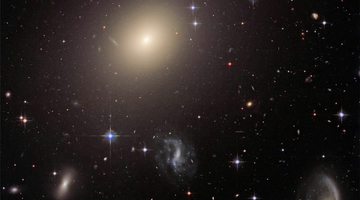Dr Melanie Johnston-Hollitt, from Victoria University of Wellington, describes what galaxies are and how they combine to form the largest structures in the universe1.
Transcript
DR MELANIE JOHNSTON-HOLLITT
Galaxies are the collections of many, many stars that we find in orbit2 about a central point. So when I am talking many, many stars, astronomers say that there are ten to the eleven stars which is one with eleven zeros after it – so a huge number of stars.
A galaxy3 cluster is the term that astronomers give to groupings of galaxies between, say, a hundred and a couple of thousand. So it’s a large collection of galaxies, each galaxy, of course, having many, many, many, many stars and then they are all connected together in the same area in space. Galaxy clusters are what we call gravitationally bound which just means like you and I are attached to the Earth because gravity4 keeps us here, these galaxies that are in the cluster actually are attached to each other through the force5 of gravity.
The Milky Way6 Galaxy is part of a number of other galaxies that are grouped together. It is not as large as some of the other groupings that we call galaxy clusters but it is what we call the ‘local group’ which includes the large Magellan Clouds which in fact the Milky Way is eating, cannibalising at a fairly fast rate on astronomical terms. And, also, Andromeda, which is another nearby galaxy that has formed part of this thing called the ‘local group’.
Acknowledgements:
John Dubinski, University of Toronto, www.cita.utoronto.ca/~dubinski/nbody/
2MASS/UMass/IPAC-Caltech/NASA/NSF
NASA, ESA, and The Hubble Heritage Team (STScI/AURA)
NASA/JPL-Caltech/GSFC/SDSS


